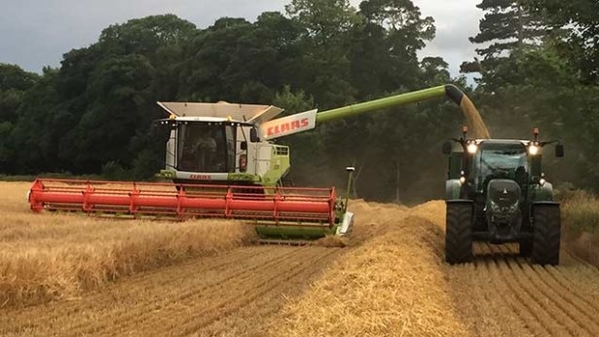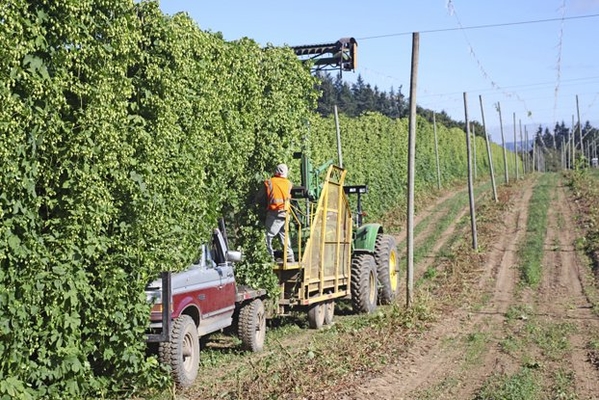Carlsberg gets to the roots of barley
Added: Tuesday, August 29th 2017

Danish brewer Carlsberg is celebrating 170 years in brewing with the news that its scientists have found the genome in barley. This will enable the brewery to develop new varieties of the grain that are resistant to drought and can be grown in regions with climates where traditional barley can’t be sewn.
The new barleys will use far less water – part of Carlsberg’s aim to reduce the carbon footprints used in the production of beer. The brewery claims to have already cut the consumption of energy by half.
Professor Birgitte Skadhauge at the Copenhagen brewery – where the first pure strain of lager yeast was developed in the 19th century – said: “We can now investigate all the genes that make up barley and can develop better strains of malting barley as a result.”
The new barleys are labelled Null-Lox and are the result of 25 years of research and development. Null-Lox3G strain has energy saving properties as less water is needed to grow it while a second strain, Null-Lox4G, has led to greater clarity in beer.
Professor Skadhauge added that her team of scientists were breeding and cross-breeding the best strains of barley and hops. One aim of the intensive and wide-ranging programme is to develop varieties of hops that can be grown in the Nordic countries and Russia, currently too cold for conventional hops to grow.
Yeast was not being ignored. On the contrary, research scientists at Carlsberg have been constantly redefining the original house yeast culture that enabled lager brewing to develop at a rapid rate in the 19th century. They have eliminated DMS – diamethyl sulphide – a compound created by fermentation that gives a “cooked corn” aroma and flavour to lager beer that is not wanted by either brewers or drinkers. They have also removed diacetyl, a compound that gives a buttery note – but this is more often found in ale rather than lager brewing and is not considered a fault by all ale brewers.
Zoran Gojkovic, director of brewing science and technology, and head brewer Erik Lund introduced samples of three experimental beers brewed in Carlsberg’s pilot brewery.
Beer No 1 was called a “single malt lager”, brewed with 100 per cent Null-Lox 4G grown on a designated field in New Zealand. It’s hoped to grow the grain in Denmark in the future. The beer was 5 per cent ABV and was hopped with Nelson Sauvin, also from New Zealand. It has a biscuit and toasted malt aroma with light lemon and lime fruit. There was gentle bitterness in the mouth, complemented by bittersweet fruit and biscuit malt. There was a shade more bitterness in the finish, the hops balanced by toasted malt and light but fading fruit.
Beer No 2 was described as a “young lager”, brewed with unripe green barley, cut on 20 June, and not malted. Erick Lund said it was grown on a field on Fuen Island in central Denmark and was harvested at a time of good sunshine while the grain was still green and sweet.

The grain was put in a juicer to extract its nutrients and was then blended with regular malt with a ratio on 30 per cent green barley to 70 per cent malt. Erik Lund said the regular malt was necessary to deliver the sugars for fermentation. The 5 per cent beer had a big minty aroma with toasted malt and light spicy hops. The mint note continued into the mouth with growing spicy hop bitterness. Mint was also evident in the finish that ended dry and spicy.
Beer No 3 was a “red lager”, described as unique by Gojkovic and Lund. It was brewed with red barley grown in New Zealand and its colour comes from anthocyanins, red molecules found in higher plants, along with antioxidants. The 5.2 per cent beer, brewed with 55 per cent standard malt and 45 per cent red malt, was bright red in colour similar to a Belgian kriek lambic. It had a spicy and peppery aroma with cherry fruit and some acidity, with butterscotch notes developing. The palate was dry with toasted malt, tart fruit and light spicy hops. Toasted malt, spicy hops and tart fruit dominated the finish.
In sharp distinction to these new beers, 1883 beer was then sampled. The 4.5 per cent beer is commercially available and is fermented with the original Carlsberg yeast from the 19th century. When an old bottle of beer was discovered in the brewery, it was possible to re-culture the yeast sediment and use it to make a fresh beer.
This version of the beer cannot be compared to closely to the original, which would have been fermented and aged in oak vessels. But Erik Lund said it was slow fermented in the traditional manner and the yeast – unlike its modern counterparts – had some diacetyl notes. The result is a beer with an earthy and slightly funky and sulphury aroma, with toasted malt and light hops. The palate and finish are dominated by rich toasted malt, gentle bitterness and a continuing funky note.
Nordic Exbeerience Dinner
To celebrate 170 years of brewing, Carlsberg brought a large party of people, including politicians and diplomats as well as writers and journalists, to a dinner where each course was dedicated to barley and accompanied by a carefully selected beer, with some dishes cooked in beer.
The menu was:
Snack: Fine de Claire oyster, black barley sour dough yeast flakes with Carl’s Special and Carlsberg Porter.
Bread: sour dough with black barley.
Starter: Chanterelle consommé, birchstock, smoked chestnut terrine and black barley with 1883 beer.
Main course: Black barley risotto, pumpkin, carrot, sauce with oysters, woodruff and malt. Beer: Jacobsen Saaz Blonde.
Pre-dessert: Jacobsen Nordic Jam gratiné.
Dessert: Barley and hops sorbet and black barley with Jacobsen brown ale. Beer: Sweet IDA (alcohol free].
Petit Four: Chocolate with elderberry beer ganache and porter marshmellow. Beer: Carlsberg Porter.
Some of the beers were brewed in the specialist Jacobsen plant that is used to create both old and innovative beer styles.








